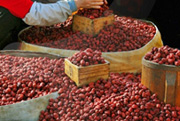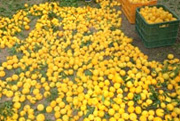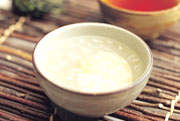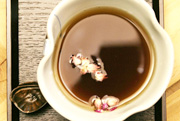Traditional Korean Teas: For Sound Body and Sound Mind
Teas are very popular and well known usually around China and Japan.
Also, there are many wonderful and amazing teas in Korea,
but not many people outside Korea knows about them.
I am a coffee lover, who cannot live without coffee,
but Korean Teas are so healty and taste delicious at the same time.
There are four types of traditional teas in Korea: green tea, medicinal herb tea, fruit-based tea, and grain-based tea. Saenggangcha (생강차, ginger tea), insamcha (인삼차, ginseng tea), and ssanghwacha (쌍화차, medicinal tea) are teas made of medicinal herbs or other traditional ingredients. Fruit-based teas include daechucha (대추차, jujube tea), yujacha (유자차, citron tea), omijacha (오미자차, Schizandra tea), mogwacha (모과차, Chinese quince tea), and maesilcha (매실차, plum tea). Grain-based teas include yulmucha (율무차, adlay tea) and boricha (보리차, barley tea). Teas from dried flowers or leaves can be made by boiling the flowers or leaves for 3 to 5 minutes. Teas from fruits, roots, or bark are brewed for 10 to 30 minutes, depending on whether the ingredients are whole or in powdered form. If the tea includes hard seeds or a mixture of various herbs, the boiling time will be longer. Tea is best prepared using soft water with a low mineral content and containers made of glass or ceramic, not metal.
| Nokcha (Green tea) |
Nokcha (녹차), or green tea, is made from tea leaves that have been dried to retain their green color. It is one of the most frequently enjoyed beverages both at home and in teahouses, and is readily available in grocery stores. Nokcha is a light delicious beverage that can be served hot or cold. Special nokcha teabags are even available for a refreshing cold green tea drink in the summer. The best temperature for brewing nokcha is between 60~68℃, ideal for retaining all the properties beneficial to health. Korean people use nokcha to enhance the green color of vegetables and to neutralize fish or meat odors. As to its medicinal effects, the catechin in green tea helps prevent food poisoning and geriatric diseases. Nokcha is widely used in cookies, cakes, bingsu (a shaved ice dessert), and ice creams to enhance both flavor and color. People also use green tea for aesthetic purposes: water infused with green tea is used for bathing, while yogurt mixed with green tea powder is often applied as a facial pack.
The tea culture in Korea was widely influenced by Buddhism and Taoism, leading to the development of Suyangdado, the performing of tea ceremonies as a way of cultivating the mind. Tea was thought to soothe the mind and create a peaceful atmosphere. Korea has long been referred to as Geumsugangsan, meaning ‘silken tapestry of rivers and mountains’, and was known as a country flowing with water, a perfect backdrop for the fulfillment of the ancient teaching that says “good tea requires good water.” The best-known tea production regions in Korea are Boseong in Jeollanam-do, Jeju-do, and Hadong in Gyeongsangnam-do, each of which annually holds a green festival. |
 |
| Medicinal Tea |
| Saenggangcha (생강차, Ginger tea)
For thousands of years ginger has been a key ingredient in dishes served throughout the world. In addition to its delicious flavor and culinary importance, the spice has great medicinal value. Ginger is believed to warm the body, ease symptoms related to fatigue and help absorb other medicinal compounds while neutralizing toxicity in the body. Saenggangcha is often taken at the first sign of a cold to prevent symptoms from getting worse, especially chills or fevers. It’s no wonder that this beverage has long since been a mainstay among Korean home remedies.
|
* Recipe: Thinly slice fresh gingerroot and marinate in sugar or honey. Add a spoonful of the mixture to hot water and stir. Or, just simply boil ginger and honey in a pot of hot water. Pour and enjoy.
|
| Purchase Information |
| Price: Powdered form (15 bags) 3,000-4,000 won, 1 kg bottle 6,000-7,000 won Place: Saenggangcha is available in powdered form or plastic bottles in department stores, supermarkets, or local markets. It is also served at traditional teahouses. |
 |
| Fruit-based Tea |
Daechucha (대추차, Jujube tea)
In Korea, Daechu (jujube) is synonymous with autumn fruit and has long been used as a medicine and in a variety of Korean dishes. The best daechu fruits are large, lustrous and deep in color. When the fruit ripens to a rich red, it is dried and ready to be made into tea. The tea is known as a powerful agent in combating colds, reducing fever, soothing neuralgia, warming the body and aiding digestion.
|
* Recipe: Add dried daechu to water and boil it down until it becomes a dark infusion. Stir a few spoonfuls of the mixture into a cup of hot water.
|
| Purchasing Information |
| Price: Powdered form (15 bags) 3,000-4,000 won, 1 kg bottle 6,000-7,000 won Place: Daechucha is available for purchase in powdered form or in plastic bottles at department stores, supermarkets, or local markets. It is also served at traditional tea houses. |
Yujacha (유자차, Citron tea) 
The deep aroma and flavor of yuja (a type of citrus fruit) make it a much-favored wintertime tea. Korean people have been making yujacha since ancient times, using the highly acidic citrus rinds of the yuja, a part of the fruit that would have had very little use otherwise. To make the tea, remove the seeds, leaving only the flesh and rind. The easiest way to make yujacha is to thinly slice the rind and boil it in water to extract the flavor. Yuja is beneficial in treating coughs, headaches, and neuralgia. It is interesting to note that yujacha is especially popular with the Japanese.
|
* Recipe: Mix slices of yuja with sugar and set aside for 3 to 4 days. Add a few spoonfuls of the mixture to hot water and stir. Drop in a couple of pine nuts for garnish and enjoy.
|
| Purchasing Information |
| Price: Powdered form (15 bags) 3,500 won, 1 kg bottle 5,000-6000 won Place: Yujacha is available for purchase in glass bottles in department stores, supermarkets, or local markets. It is also served at traditional teahouses. |
| Grain-based Tea |
| Yulmucha (율무차, Adlay tea)
A perennial plant of the family Poaceae, yulmu (aka, Adlay or Job’s tears) is a healthy grain with a higher protein and fat content than rice. The grains of yulmu are dried and ground into a powder, which is then added to boiling hot water. Valued by Koreans as a healthy pick-me-upper, the tea can be purchased in powdered form in grocery stores. It is also widely available in coffee vending machines.
|
* Recipe: Dry the grain of yulmu and grind it into a powder. Mix into boiling hot water.
|
| Purchasing Information |
| Price: 1 kg powdered form 4,000-5,000 won, individually packaged (100 bags) 15,000 won~16,000 won Place: Yulmucha is available for purchase in powdered forms in department stores, supermarkets, or local markets. It is also served in traditional teahouses. |
| Traditional Beverages |
Sikhye (식혜, Sweet rice drink)
Sikhye is a traditional sweet Korean beverage served after a meal or during teatime. It is sometimes called dansul or gamju, but these terms can also refer to other beverages containing alcohol. Sikhye is made from cooked rice and barley malt powder. In days past, the drink accompanied meals because it was believed to aid digestion. In wintertime, sikhye was garnished with a few pine nuts to prevent the drinker from gulping the cold beverage too fast and giving him or herself a stomachache. Today, sikhye is served as a dessert in many restaurants, and it is readily available in cans or plastic bottles in grocery stores and convenience stores. Sikhye is often made at home as part of holiday celebrations and has become a favorite thirst-quencher at jjimjilbangs.
|
* Recipe: Pour malt water into a pot containing steamed glutinous rice, and leave it to ferment. After it is fermented, remove the rice and rinse it in cold water. Boil with sugar and ginger, and set aside to cool. Pour some of the drink into a cup, add some rice sugar, and top it off with pine nuts.
|
| Purchasing Information |
| Price: Can 600 won, 1.8L plastic bottle 3,500~4,000 won Place: Sikhye is available in cans or plastic bottles at supermarkets, convenience stores, and local markets.. |
Sujeonggwa (수정과, Persimmon punch) 
Sujeonggwa is a sweet and pungent traditional drink that is customarily used as a palate cleanser. Usually made on New Year’s Day (January 1 by the lunar calendar), Sujeonggwa is made using dried sweet persimmons, cinnamon, and ginger. The ingredients combine to produce a fragrant aromatic drink that is said to warm the body and even cure hangovers. Together with sikhye, sujeonggwa has long been a favorite traditional beverage of the Korean people, and can easily be found in retail stores in cans or plastic bottles. It is also often served as a dessert in traditional Korean restaurants.
|
* Recipe: Simmer ginger and cinnamon sticks and then add sugar or honey. Garnish with dried persimmon and pine nuts.
|
| Purchasing Information |
| Price: Can 600 won, 1.8L plastic bottle 3,500~4,000 won Place: Sujeonggwa can be purchased in cans or plastic bottles at your local supermarket. |
댓글 없음:
댓글 쓰기